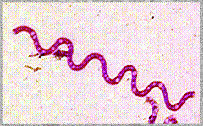


 email: jho@dres.dnd.ca
email: jho@dres.dnd.ca
![[DRES Logo with FLAPS title]](flaps1.gif)
Our discovery, using conventional flow cytometry techniques, that a single bacterial spore in liquid could be induced to fluoresce, led us to build the Fluorescence Aerodynamic Particle Sizer (Flaps) for measurement of biological aerosols. This instrument was designed to measure particle size and fluorescence for each particle in an air stream, hence, functionally is a flow cytometer by definition. With this capability, analysis of the data permitted the experimenter to distinguish between biological aerosol particles and inanimate material like sand. Respirable particles (0.5-15 µm size range) are sized by the time-of-flight method, initiated by HeNe laser while biological related fluorescence is elicited with excitation by HeCd UV laser at 325 nm. Particles containing molecules that are excitable at this wavelength emit light at between 400-580 nm. Fluorescence characteristic is suggestive of biological properties inherent with the particle. There is widely available evidence demonstrating that this type of observation is related to actively metabolizing "live" organisms synthesizing intracellular fluorescent biomolecules like NADH and riboflavin.
![[Optical diagram]](optical.gif)
This illustrates the relationship between the various exciting and emitting light paths with respect to an aerosol stream. Particles accelerating through the nozzle oriented 90 degree incident to the diagram first encounter 2 red laser beams that measure time-of-flight. An electronic trigger then opens a timing window to measure fluorescence just as the particle traverse the UV beam located distal to the red beams. Fluorescence brightness information is stored with particle size information for each object and after a prescribed sampling interval (3 seconds), data packets are transmitted to a PC for display.
![]() Engineering
and Manufacturing of Flaps was performed by TSI
Engineering
and Manufacturing of Flaps was performed by TSI
http://www.tsi.com
![]() 3D
Display Software was produced by Dycor
3D
Display Software was produced by Dycor
http://www.dycor.com
Naturally occurring environmental aerosols contain low biological content so a particle concentrator (350 to 1) is used to increase the signal to noise characteristics for the Flaps. When detecting artificially generated biological aerosols, further improvement in signal to noise can be achieved by "gating" out dimly fluorescing particles as well as those <2.5 µm in diameter.
![[3D histogram]](bkg1.gif)
This diagram shows an analysis of relatively clean air with gating. Fluorescence (Fl) is plotted vs particle size distribution (µm) vs numbers after 3 seconds sampling time. Under normal steady state background atmospheric conditions the fraction of fluorescing particles rarely measured above 5%.
![[3D histogram]](drybg1.gif)
In contrast, in the presence of a simulant biological aerosol (harmless Bacillus spores, BG) a significant increase in the number of brightly fluorescing particles can be seen, especially in the larger size range (5-10 µm).
![[Line plot]](trial2.gif)
In a recent Joint Field Trial (JFT) held during September 1995 (UK, US & CA) Flaps was used to detect biological simulant aerosols. As an illustration, the Flaps data can be plotted to show time based events; in this case, total gated particle numbers is compared to gated % fluorescent particles. Indicated here is the time of arrival of the simulant cloud, confirmed by standard reference biological samplers along with measurement of a tracer gas (propylene). It can be seen that measuring the fraction of gated fluorescent particles is a sensitive method to represent the presence and dynamic passage of biological aerosol.
All the trials are listed in this diagram as simulants used during dissemination, including controls (water). Negative controls represent instances where simulants were sprayed but due to wind conditions, did not arrive at the Flaps location (verified by Dugway reference AGI samplers). The diversity of biological simulants are represented by Erwinia herbicola as vegetative bacterial; MS2 phage as virus; and ovalbumin as protein based toxins. Except for the four known sprays (denoted by *) all other disseminations were produced without prior notification. Of the positive spray experiments, Flaps detection success rate was 97% (in one case there was a laser failure). There was 0% false alarm rate.
![[bar graph]](summary1.gif)
Flaps can be used for detection of biological aerosols in the following situations:
![]() Environmental monitoring
of sewage treatment plants and feed lots
Environmental monitoring
of sewage treatment plants and feed lots
![]() Air quality control
in clean rooms
Air quality control
in clean rooms
![]() Hospital operating
room alarm system
Hospital operating
room alarm system
![]() Food and drug processing
plants
Food and drug processing
plants
A commercial version of this instrument (Flaps2) is marketed by TSI and Dycor.
![[FLAPS logo]](flaplogo.gif)
This neat logo looks really nice on a golf shirt.
Email hank@dycor.com for local Canadian and international enquiries.
![]() If you have any comments or suggestions regarding the intellectual content
of this document, please send e-mail to jho@dres.dnd.ca.
If you have any comments or suggestions regarding the intellectual content
of this document, please send e-mail to jho@dres.dnd.ca.
![]() If you have any comments or suggestions regarding the design or layout
of this document, please send e-mail to webmaster@dres.dnd.ca.
If you have any comments or suggestions regarding the design or layout
of this document, please send e-mail to webmaster@dres.dnd.ca.
![]()
![]()
 Back to Flow Cytometry and Microbiology Introductory Page
Back to Flow Cytometry and Microbiology Introductory Page
